Small Shrubs (With Pictures) – Identification Guide
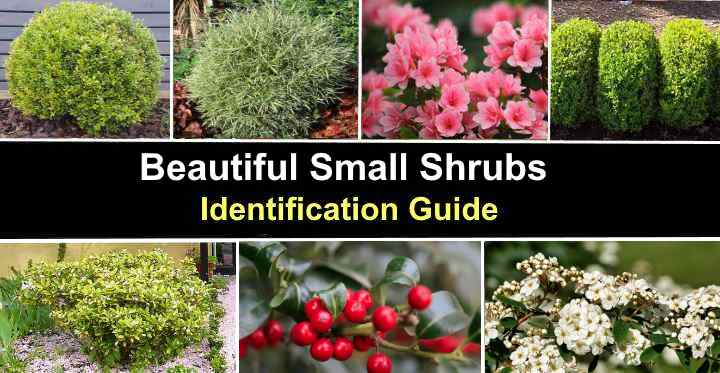
Small shrubs are a terrific way to add greenery, color, and texture to your outdoor space. Low-growing landscaping shrubs can grow in tight spaces, compact gardens, or limited yard spaces without taking up too much room. Small deciduous shrubs can provide lush foliage, fragrant flowers, and visual appeal from spring through fall. Also, small evergreen shrubs are perfect for privacy and year-long greenery to keep your front or backyard looking healthy.
The wide variety of small shrubs can make it challenging to choose the best. Small bushy plants like boxwoods are ideal for formal gardens, foundation planting, or hedgerows. Short shrubs like azaleas, Japanese skimmia, and spirea fill garden landscapes with stunning floral displays. Additionally, many low-growing shrub varieties are perfect for ground cover.
This article identifies some of the best small shrubs for your front or backyard. Additionally, pictures of small bushes for landscaping will help you decide the most suitable ones for your property.
What Are Small Shrubs?
Small shrubs are compact, bushy plants that grow up to 3 to 5 ft. (1 – 1.5 m) tall. A variety of short shrubs are deciduous or evergreen, and some coniferous shrubs are under two feet tall. Generally, small shrubs for garden landscaping are drought-tolerant and low-maintenance, making them perfect for foundation planting, rock gardens, shrub borders, and informal hedges.
The Benefits of Small Shrubs in a Garden Landscape
Small shrubs add great aesthetic value, beauty, and functionality to a garden landscape. These compact shrubby plants of less than five feet tall can have colorful leaves and fragrant blooms, adding visual interest and curb appeal to your home. Additionally, many small shrubs have dense foliage that can serve as a natural fence, giving more privacy to your outdoor space.
Landscape uses for growing small shrubs in your front or backyard include the following:
- Foundation planting
- An informal or formal hedge
- A privacy screen or noise barrier
- An eye-catching garden border
- Understory shrubs to accent taller flowering shrubs or trees
- Container planting on a patio, deck, or balcony
- Enhance your property with seasonal interest and color
How to Choose the Best Small Shrubs For Your Yard
When choosing the best small shrubs for your yard, there are a few factors to consider. First, check your USDA cold-hardiness zone. Some small shrubs cannot tolerate freezing temperatures. Next, think about sun exposure, shade, soil condition, and maintenance needs. Additionally, some short, small shrubs perform better in coastal areas than others.
Small Shrubs (With Pictures)
Please read on to learn how to choose the best small shrubs for your landscaping needs. Descriptions and pictures of compact and low-growing shrubs will help you decide on the best plants to enhance the aesthetic appeal of your garden.
Forsythia ‘Happy Centennial’
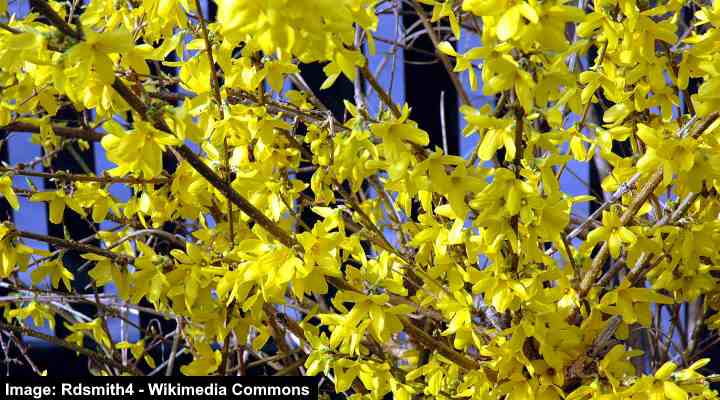
Dwarf forsythia cultivars are hardy shrubs that make a good choice for fast-growing flowering hedge for front of house
Forsythia ‘Happy Centennial’ is a compact deciduous shrub less than three feet tall. Its eye-catching features are bright yellow flowers on bare stems followed by dark green, dense foliage. In spring, the yellow four-petaled blossoms cover the entire shrub, creating a stunning floral display in a sunny garden.
Forsythia ‘Happy Centennial’ grows 2 to 3 ft. (0.6 – 1 m) tall and up to 5 ft. (1.5 m) wide. The vigorous shrub is ideal for planting as a hedge, specimen plant, or foundation planting. Its drought, heat, and moist soil tolerance make it a versatile shrub.
Forsythia ‘Happy Centennial’ is suitable for growing in USDA zones 5 to 9.
Winter Heath (Erica carnea)
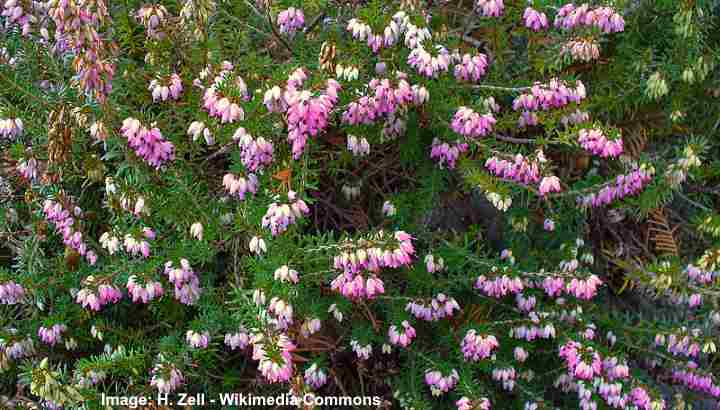
The ornamental small winter heath shrub is grown for its evergreen foliage and purple flowers and is suitable for full sun
Winter heath is a small flowering shrub under two feet tall. Varieties of this small evergreen shrub grow between 0.5 and 2 ft. (0.15 – 0.6 m) tall. The small shrub’s ornamental features are its spikes of urn-shaped pink, red, white, or orange flowers, short, needle-like foliage, and winter-blooming habit.
Short winter heath shrubs are perfect for adding color to a winter garden when most other plants are dormant. The beautiful low floral displays enhance shrub borders, cottage gardens, rock gardens, and containers. In addition, their tolerance for salt spray makes them ideal for landscaping compact gardens in coastal regions.
Winter heath is suitable for growing in full sun in USDA zones 5 to 7.
Japanese Skimmia (Skimmia japonica)
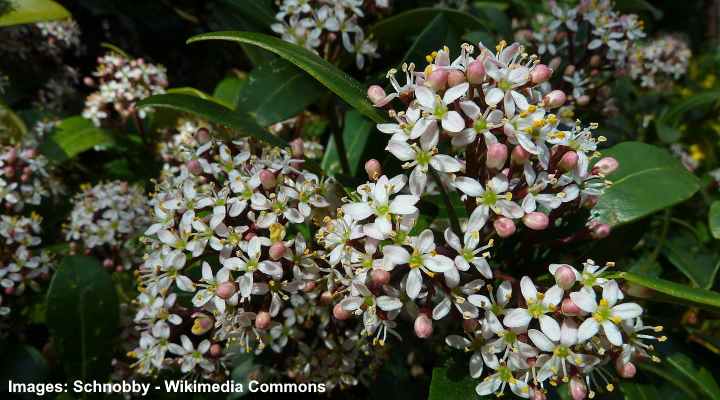
Japanese skimmia is a small flowering evergreen shrub that is easy to care for and loves shade
Japanese skimmia is a short evergreen shrub noted for its pink-white flowers, leathery leaves, and showy red fruits. This small landscaping shrub has conical clusters of star-shaped fragrant flowers that appear white or pink. The evergreen foliage contrasts with the shrub’s bright red berries that appear in the fall and persist through winter.
Japanese skimmia thrives in the shade—perfect for growing along a fence line or the north-facing side of your house. The ornamental shrub grows 3 to 4 ft. (1 – 1.2 m) tall and up to 5 ft. (1.5 m) wide. This slow-growing rounded shrub is ideal as a specimen plant, flowering hedge, shrub border, or patio container.
Japanese skimmia is suited for growing in the shade in USDA hardiness zones 6 to 8.
Virginia Sweetspire ‘Little Henry’ (Itea virginica ‘Little Henry’)
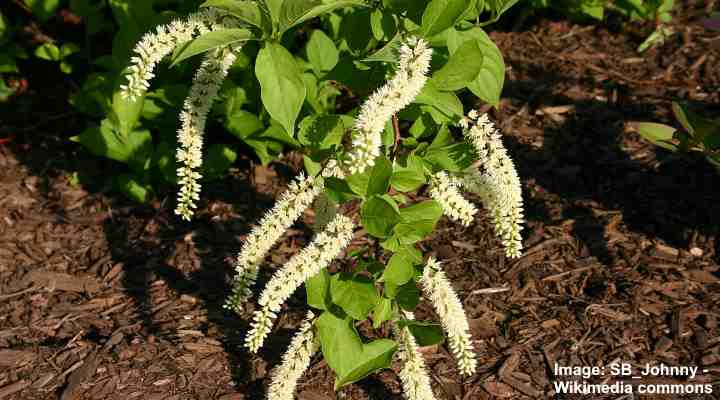
The low growing Virginia sweetspire ‘Little Henry’ shrub is great for landscaping compact spaces
Virginia sweetspire ‘Little Henry’ is a low-growing, compact deciduous shrub under 3 feet tall. The small shrub is covered in white bottlebrush flowers in spring and summer. The cylindrical, fuzzy, fragrant flowers cover the shrub’s dark green leaves. In the fall, the leaves of this deciduous shrub turn brilliant shades of red or orange, enhancing your home’s curb appeal in three seasons.
Ideal for growing in full sun or complete shade, Virginia sweetspire grows 2 to 3 ft. (0.6 – 1 m) tall. The creamy-white bottlebrush flowers grow 2” to 6” (5 – 15 cm) long, and its leaves measure up to 4” (10 cm).
This short, low-maintenance, drought-tolerant versatile shrub is a popular landscaping choice as a foundation, container, or hedge plant. It also tolerates soggy ground, making it a good shrub to grow near streams or ponds.
Virginia sweetspire ‘Little Henry’ thrives in full sun to shade and is suitable for planting in USDA zones 5 to 9.
Small Wintercreeper Shrubs (Euonymus fortunei)
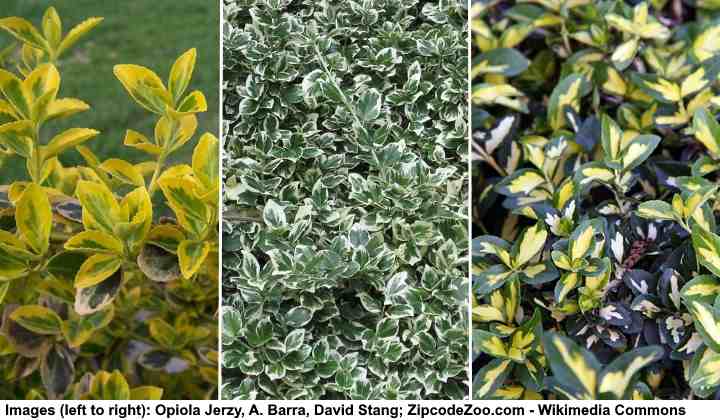
The colorful foliage of small evergreen wintercreeper shrubs add an ornamental element to any garden. This picture shows the compact cultivars: ‘Emerald ‘n’ Gold’, ‘Emerald Gaiety’ and ‘Moonshadow’
Small wintercreeper shrubs are low-growing bushy plants for landscaping due to their brightly-colored foliage. These evergreen shrubs feature small, rounded, or pointed, glossy green leaves with various shades of variegation—white, gold, or yellow. Ideal for full sun ground cover, the shrubs grow 1 to 5 ft. (0.3 – 1.5 m) tall.
Here are four varieties of wintercreeper landscaping shrubs that don’t grow taller than five feet:
Wintercreeper’ Emerald Gaiety’—The low-maintenance small shrub has green and creamy-white variegated leaves. Its leaves are oval-shaped, glossy, and have a waxy texture. It grows 4 to 5 ft. (1.2 – 1.5 m) tall and wide. Ideal for foundation planting or low hedge.
Wintercreeper ‘Emerald ‘n’ Gold’—This short, spreading evergreen shrub has brightly colored green and gold leaves, creating a mat of colorful foliage. The short shrub grows 1 to 2 ft. (0.3 – 0.6 m) tall and up to 4 ft. (1.2 m) wide. It is often used as a ground cover in shade or sun or for borders. It will also climb vigorously and over a fence line or shaded wall.
Wintercreeper ‘Canadale Gold’—This small evergreen shrub has vining stems and variegated bright yellow leaves with pale green centers. It grows 2 to 3 ft. (0.6 – 1 m) tall. You can use this wintercreeper shrub for ground cover, edging, foundation planting, or climbing walls and fences.
Wintercreeper ‘Moonshadow’—This small shrub reaches 3 ft. tall (0.9 m) and has brightly colored yellow and green foliage. Grow as a small border shrub wherever you need bold colors in your front or back garden.
The low-maintenance shrubs are suitable for planting in USDA zones 5 through 9. They are perfect for adding color and texture to a sunny landscape.
Winter Daphne (Daphne odora ‘Aureomarginata’)
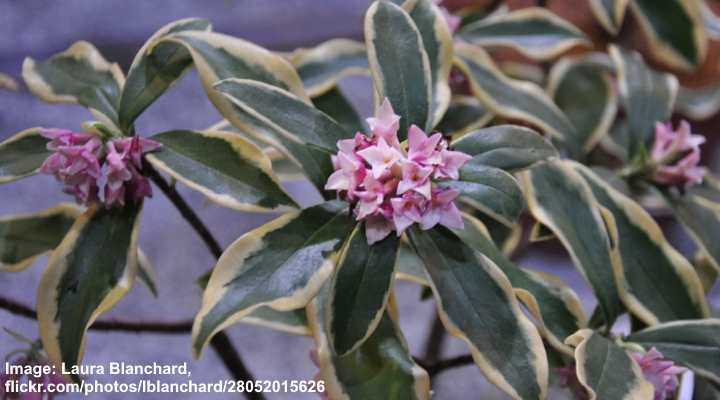
The small flowering evergreen winter daphne ‘Aureomarginata’ has attractive variegated leaves and doesn’t require much care
Winter daphne is a stunning evergreen shrub prized for its dark green leaves with creamy-white margins. Outstanding ornamental features of winter daphne are its clusters of white and pink, star-shaped flowers, leathery variegated leaves, and tiny red berries. Adding to its landscaping value, the low shrub thrives in partial shade.
Winter daphne grows 3 to 4 ft. (1 – 1.2 m) tall and wide. Its compact growth makes it perfect for growing in tight spaces or small residential gardens. You can plant it as an evergreen flowering hedge, foundation plant, or shrub border in partial shade or dappled sunlight.
This slow-growing winter daphne shrub is hardy in USDA zones 7 to 9.
Small Boxwood Shrubs (Buxus spp.)

Place small evergreen boxwood shrubs in the front of house to increase the curb appeal or as a decorative element in your backyard
Boxwood shrubs are small, decorative evergreen shrubs, many of which don’t grow taller than five feet. The hardy, shrubby landscaping plants thrive in various soil types and perform just as well in the shade as in day-long sunshine. Low-growing boxwood shrubs grow 1 to 5 ft. (0.3 – 1.5 m) tall and wide
Here are three varieties of miniature boxwood shrubs for landscaping:
Small-leaved boxwood ‘Faulkner’—This tough, hardy, compact boxwood shrub has small, glossy dark green leaves. It has a rounded habit and doesn’t grow taller than four feet. Its most common landscape use is as a low formal hedge, garden divider, container plant, or foundation planting. Its evergreen foliage turns bronze in winter.
Japanese boxwood ‘Green Beauty’—Identifying features of this compact shrub are its tiny lanceolate, glossy green leaves, and irregularly rounded growth habit. It grows 3 to 5 ft. (1 – 1.5 m) tall and wide. It’s commonly used as a short hedge or border plant.
English boxwood ‘Suffruticosa’—This slow-growing, evergreen shrub has small, glossy leaves and a dense, compact habit. It is commonly used for hedges, topiaries, and as a border plant. The shrub grows 2 to 3 ft. (0.6 – 1 m) tall and up to 4 ft. (1.2 m) wide.
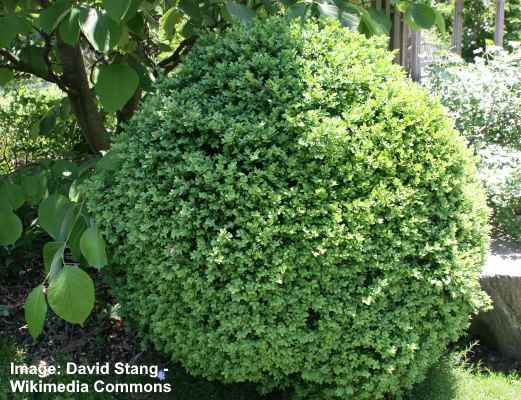
Dwarf English boxwood (Buxus sempervirens Suffruticosa)
Small Azalea Shrubs (Rhododendron spp.)
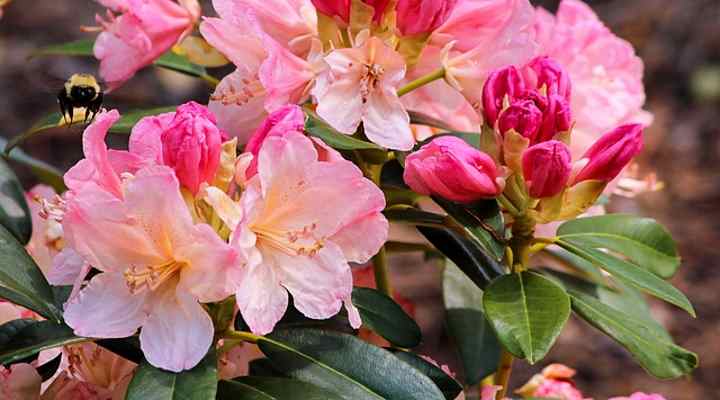
Flowering azalea shrubs include small cultivars that will give stunning color to any landscaped garden
Azaleas are small flowering shrubs renowned for their clusters of colorful, showy flowers. Small azalea shrubs have trumpet-shaped flowers in pink, red, white, yellow and purple shades. These long-lasting floral displays stand out against the lush, leathery green foliage. Small azalea shrubs grow 3 to 6 ft. (0.9 – 1.8 m) tall and wide, depending on the variety.
Small azaleas are ideal for landscaping in compact, sunny gardens. Most azaleas are deciduous shrubs; however, some exotic varieties have evergreen foliage in southern landscapes.
Related reading: Stunning varieties of azalea shrubs.
Small Barberry Shrubs For Landscaping (Berberis thunbergii spp.)
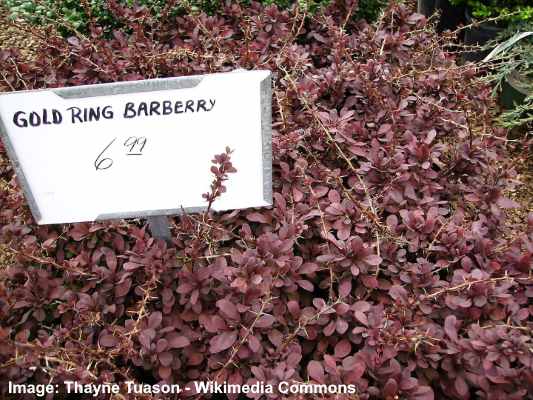
Golden ring barberry (Berberis thunbergii f. atropurpurea ‘Golden Ring’) is a small shrub with decorative purple leaves
Most varieties of barberry shrubs are low-growing deciduous shrubs with colorful foliage and fragrant flowers. Ornamental features of barberry shrubs are their oval leaves in red, green, and chartreuse hues growing on red stems, clusters of small fragrant flowers, and barbs or spines on their branches. Additionally, the shrubs produce bright red or blue-black berries.
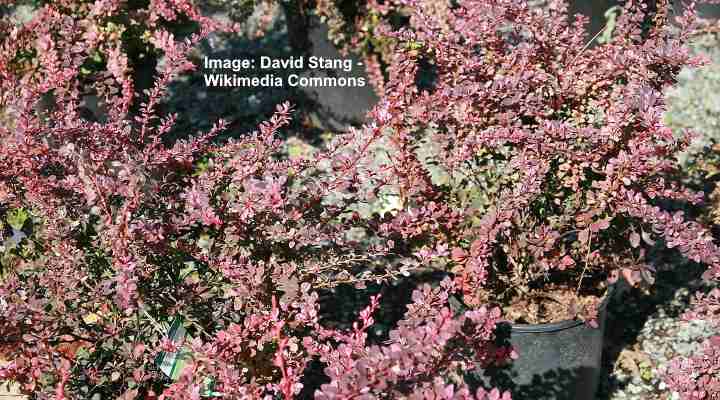
Rose glow barberry (Berberis thunbergii var. atropurpurea ‘Rose Glow’) is a deciduous shrub that grows up to 4-5 ft. (1.2-1.5 m)
Small barberry shrubs grow 1 to 6 ft. (0.3 – 1.8 m) tall and wide. The small shrubs for landscaping thrive in full sun or partial shade. The sun-loving shrubs perform well as a low hedge, security border, foundation planting, or accent shrub.
Small barberry shrubs thrive in USDA zones 4 through 8.
Small Hydrangea Shrubs (Hydrangea macrophylla)

Hydrangea macrophylla ‘Endless Summer Bloomstruck’ is 3 to 4 ft. (1 – 1.2 m) tall and up to 5 ft. (1.5 m) wide
Due to their impressive rounded flowerheads, small hydrangea shrubs are perfect for landscaping in sunny front or backyards. The ornamental shrubs grow 3 to 5 ft. (1 – 1.5 m) tall. Their huge flower clusters can be shades of blue, pink, purple or white and bloom for several months of the year. The flowers contrast with large, lance-shaped green leaves.
Landscaping uses for small hydrangea shrubs include mixed borders, a flowering hedge, foundation planting, or container flowers. Small hydrangea shrubs thrive in USDA zones 5 to 9 and require regular watering and fertilization.
Further reading: Types of hydrangea bushes (small and large).
Small Spirea Shrubs (Spirea spp.)
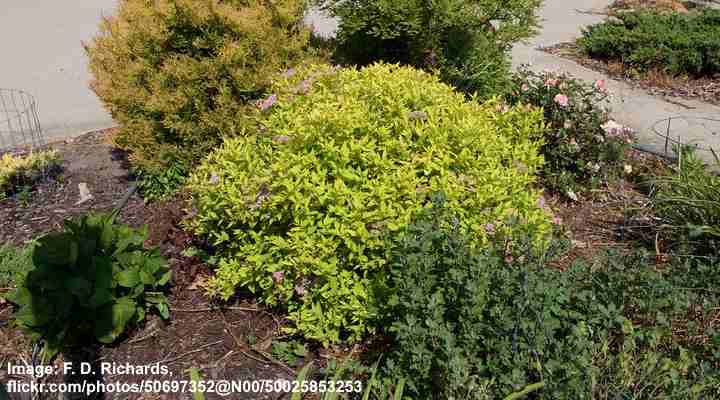
Gold Mound Japanese spirea (Spiraea japonica ‘Gold Mound’) grows to 2 – 3 ft. (60 – 90 cm) tall and 3 – 4 ft. (0.9 – 1.2 m) wide
Spirea shrubs are small ornamental bushy landscape plants that generally don’t grow more than three or four feet tall. The deciduous shrubs have small, heart-shaped leaves and large conical fuzzy flowering plumes. The vigorous shrubs have a clumping habit and are perfect for cottage gardens and marshy ground.
Depending on the variety, spirea shrubs grow on average between 3 and 5 ft. (1 – 1.5 m) tall and wide. The fragrant plume-like flowers can be white, pink, or purple and bloom in spring and summer.
Typical uses for spirea shrubs in a sunny landscape include ground cover, foundation planting, decorating borders and edges, and growing in containers.
Spirea shrubs thrive in USDA zones 4 to 9; however, some varieties are more cold hardy for zone 3.
Bird’s Nest Spruce (Picea abies ‘Nidiformis’)
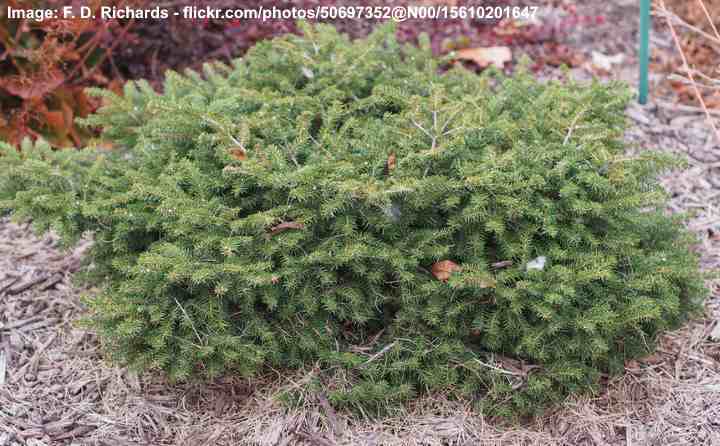
The birds nest spruce is a slow growing small evergreen shrub with round shape and flat top
Bird’s nest spruce is a slow-growing, short coniferous shrub under two feet tall. The miniature evergreen shrub is perfect for landscaping sunny gardens. The eye-catching feature of this spruce shrub is the horizontally spreading stems of needle foliage that create a flat-topped disk-like evergreen shrub. The depression in the center makes it resemble a bird’s nest.
Bird’s nest shrub grows up to 2 ft. (0.6 m) tall and 4 ft. (1.2 m) wide, making it perfect for small gardens to grow along a foundation, decorate a rock garden, or grow as a specimen plant.
Bird’s Nest Spruce requires full sun to thrive but performs best in cool climates. Its unique shape and texture make it an excellent addition to any landscape design. The coniferous shrub is suitable for growing in USDA zones 3 to 8.
Further reading: Dwarf conifer shrubs for garden landscaping.
Inkberry ‘Shamrock’ (Ilex glabra ‘Shamrock’)
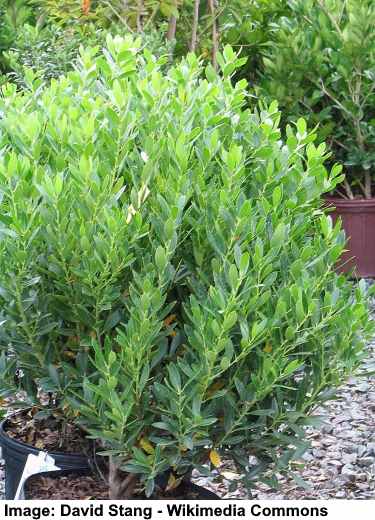
Inkberry ‘Shamrock’ is a small easy to care for evergreen shrub that tolerates poorly-drained soil
Inkberry ‘Shamrock’ is a compact evergreen shrub, ideal for small gardens and tight spaces. The eye-catching features of the bushy shrub are its rounded habit, dark green, lush foliage, greenish-white flowers, and clusters of tiny black berries. The small flowers attract pollinators, and the berries attract birds in the fall.
Inkberry ‘Shamrock’ grows 3 to 4 ft. (1 – 1.2 m) tall and wide. Popular landscape uses in sunny or partially shaded yards include a low-growing hedge, foundation planting, or shrub border. Additionally, it performs well in wet soils, making the small shrub a perfect choice for growing along streams or in bog gardens.
Inkberry ‘Shamrock’ is suitable for growing in USDA zones 4 to 9.
Winterberry ‘Little Goblin Red’ (Ilex verticillata ‘Little Goblin Red’)

Winterberry ‘Little goblin red’ is an ornamental small deciduous shrub with red berries in the winter
Winterberry ‘Little Goblin Red’ is a deciduous holly shrub perfect for small spaces. The attractive small shrub produces clusters of greenish-white flowers followed by bright red berries in that fall that persist into winter. The vibrantly-colored red berries provide a pop of color in drab winter landscapes.
Winterberry ‘Little Goblin Red’ grows 3 to 5 ft. (1 – 1.5 m) tall and wide. Thriving in full sun to partial shade, it’s ideal for the following landscape uses:
- Foundation planting
- Specimen plant
- Low-growing hedge
- Hardy shrub for boggy areas or growing near ponds or streams
Winterberry ‘Little Goblin Red’ is suitable for growing in USDA zones 3 to 9.
False Cypress ‘Golden Charm’ (Chamaecyparis pisifera ‘Golden Charm’)
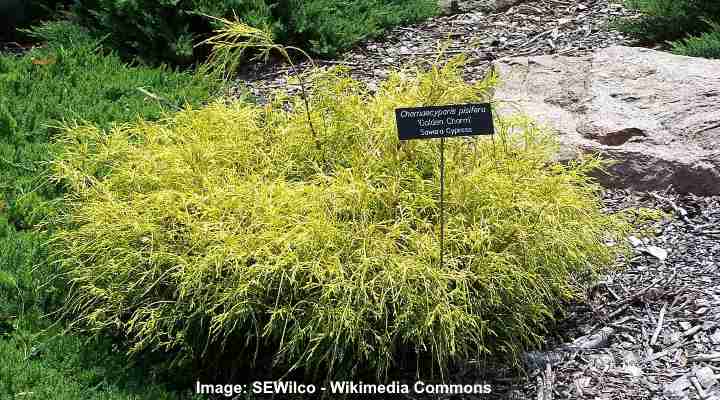
The low growing golden charm false cypress is an evergreen shrub and is great for front of house landscaping
False cypress ‘Golden Charm’ is a dwarf coniferous shrub with golden yellow feathery, scale leaves. Also called the Sawara cypress, the hardy shrub has soft yellowish-green foliage that adds unusual color throughout the year. False cypress ‘Golden Charm’ grows 3 to 5 ft. (1 – 1.5 m) tall and 4 to 6 ft. (1.2 – 1.8 m) wide.
You can grow false cypress ‘Golden Charm’ in full sun or partial shade in USDA zones 4 to 8. The small bushy conifer shrubs are perfect for foundation plantings, rock gardens, or specimen plants. False cypress ‘Golden Charm’ is also deer-resistant and drought-tolerant.
False cypress ‘Golden Charm’ is suitable for growing in USDA zones 4 to 8.
Related articles:
